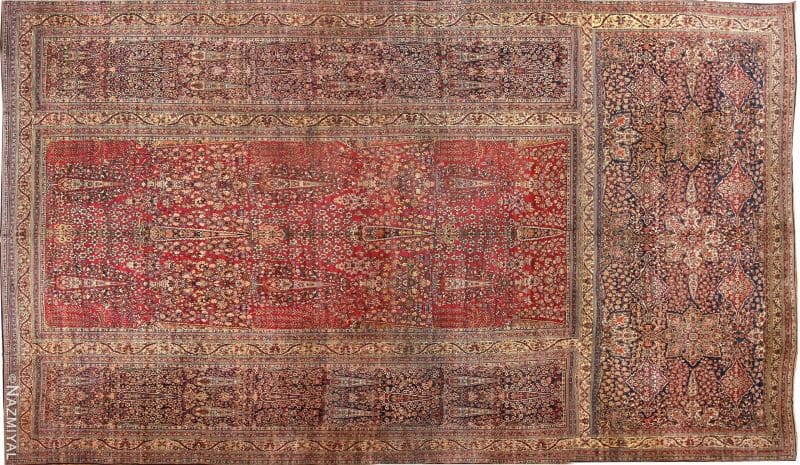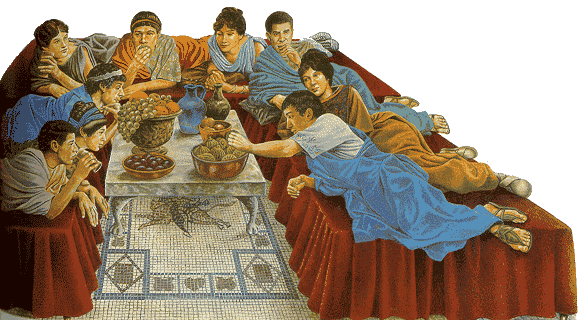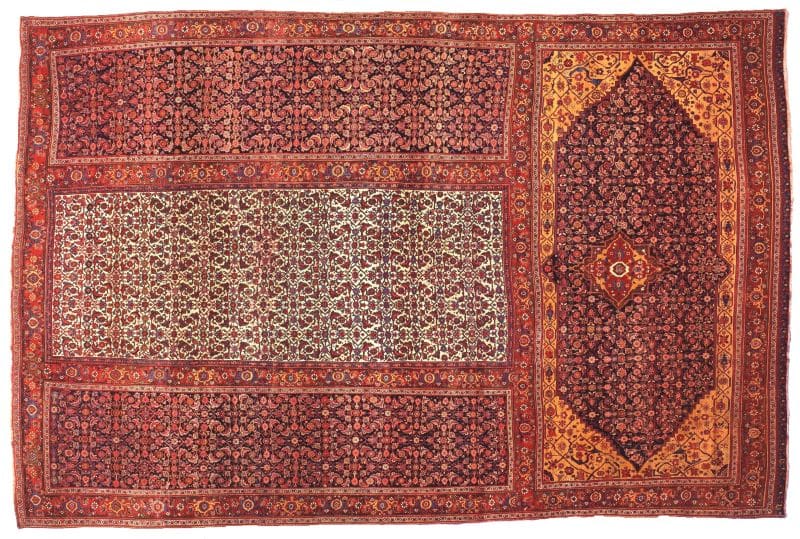Triclinium Rugs
View Our Collection Of Triclinium Rugs
Triclinium Rugs: Creating A Formal Space
What are triclinium rugs?
The term “Triclinium rugs” refers to rugs that have a design with the appearance of four rugs placed together. While it is believed that historically these rugs were sold individually in a grouping, triclinium rug now refers to one individual rug. The most common use of these triclinium rugs is to house a low table on the main, center carpet and provide floor seating on the runner rugs around it. They are rare rugs, and most of them in existence are antiques with no new ones being produced in recent years. They are a real treasure to find in the world of Oriental carpets.

An example of a triclinium rug.
The Triclinium Rug Grouping
The Triclinium rug consists of four rugs. There is a main rug that is relatively large. Two runner rugs are placed on the sides of this one lengthwise. Across the top is another area carpet that has a length equal to the width of the main rug and the two runners beside it. The grouping is large; it is meant to fill the entire space of a room. This grouping makes it possible to put a low dining room table in the middle and pillows around the outside for eating, coffee, and conversation.
The origin of the triclinium table is thought to have originated in the Roman Empire, with the practice continued to be carried out in several different cultures. The word “triclinium” specifically refers to three sides of a low table with couches placed on these three sides to accommodate eating in a reclining position. The fourth side of the table was open to allow for service to the table. The open side of the table was placed so that it faced the entrance to the room.
These antique rugs and their accompanying table and customs were a sign of wealth. In some Roman households, this setting was for formal meals only, and the everyday meals for the family were served in another room. In Roman households, the triclinia is often adjoining the bath. This is the original form of the custom. The Greeks later adopted that practice. The use of the couches for dining faded away. Still, the tradition of the triclinium rug and eating on the floor using floor cushions around a low table continues in formal settings throughout the Middle East today.

An example of triclinium seating around a dinner table.
Bidjar Triclinium Rugs
It is believed that historically, all four of these rugs were sold separately as a grouping. The idea of connecting them as a single rug appears to have come later. Sometimes, those made for exceptionally large rooms are still sold as groupings of four. They are often related in terms of pattern and color, working together to form a unified appearance. Sometimes, they might appear as if they are four different carpets, but they are unified through a central theme or motif. In Persia, they are called a “dasteh“, which means a team of horses or handful.
A majority of them are from Bidjar and were produced in the late 1800’s. A few can be found that come from other areas, but the most common triclinium rugs are from this area of Persia. Bidjar is a small city that is located in what is now Kurdistan, Iran. Antique Persian Bidjar rugs have several characteristics that make them unique. They are often heavy and durable rugs because of a weaving technique that is unique to this area.

A triclinium rug often looks like four rugs stitched together.
Bidjar carpets are often extremely heavy and exceptionally durable. They are tightly woven and are often heavier when compared to other carpets of the same size from different areas of Persia. They are also known for their spectacular color combinations. Even though they are produced in Persia, they often use the Turkish rug knot, which creates a more durable carpet.
This durability comes from wetting the weft rows that are placed between the knot rows. A row of Ghiordes rug (or Turkish) knots are placed according to the desired color pattern. Then the weft thread is wetted and placed between the rug knot rows. Sometimes one weft row is used, and sometimes two are used. This is then packed down tightly using a beating comb. When the carpet dries, the wetted weft threads shrink, creating a tighter weave carpet.
This is a characteristic of Bidjar carpets that makes them exceptionally durable and able to be used for areas of the home where they will receive continual use. Bidjar carpets have excellent wear qualities and are suitable for high-traffic areas. They have been called the Iranian “iron carpets” because of their tight weave. They are thick and have a plush feel. The best Bidjars have a clear design and use incredible levels of detail in the designs.
The four carpets of the triclinium rug can use any number of Bidjar rug designs. Common elements include willow trees, cypress trees, the Shah Abbasi palmette and medallion designs. They are made using vibrant colors created using vegetable dyes. Bidjar carpets can be extremely large, especially the triclinium rugs that are meant to fill the entire space.
A triclinium rug is a rare find and an excellent addition to the room. They are collectible and make an excellent way to define a space with an open plan studio. They also make a unique way to define a conversation area, as they were initially intended. One of the best parts about the triclinium rugs is that it is like having four carpets in one.
Now that you know the origin of the triclinium rug enjoy searching our rugs online because sometimes, we have the opportunity to offer one of these unique pieces.
